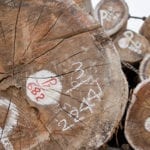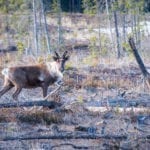A few years ago, I went to my local hardware store and bought a basic 8-foot long “two-by-four” stud to use in a teaching demo. It cost about $2.50 in Canadian dollars. As I write this article, that same piece of wood is listed online for $8.59. Yikes! Unprecedented prices like these are currently adding a whopping $30,000 to the cost of a new 2,500 sq. ft. home, eroding affordability. Moreover, prices aren’t only expensive here in Canada—they are soaring globally. What is behind these mammoth price increases?
Business analysts are largely blaming the price spike on COVID-19. While a boom in single-family home construction is raising demand for lumber products (such as my two-by-four), COVID-19-related temporary mill closures and transportation delays caused shortages, resulting in higher prices. However, long-term supply (read: forests) and pre-COVID-19 demographic trends are also at play. It is here that science helps us understand what is happening today and what may happen in the future.
Forest economics provides insight into market behaviour
A study in the Canadian Journal of Forest Research (CJFR) provides a good starting point for understanding how softwood prices change over time. Then-graduate student Fan Zhang and Professor Sun Joseph Chang of Louisiana State University examined trends in softwood log markets in Louisiana over a 30-year period, observing how prices changed in relation to log demand and the volume of logs harvested. They found the demand for logs to be inelastic; even when prices rise, demand remains relatively static. When prices rose, forestland owners responded by selling more logs. But even when they responded quickly, it took time (often several months) for the logs to sate the unmet demand and for prices to go back down.
Lumber markets work in much the same way. Even when faced with higher-than-expected prices, a homebuilder will still buy the lumber they need to finish all four walls of their house, passing the extra cost on to the homebuyer. Farther up the supply chain, lumberyards looking to supply their customers’ lumber needs will negotiate with sawmills to purchase this lumber–paying more when they are competing for supply and asking for discounts when supply is abundant. Hence, lumber prices rise (and fall) across the marketplace.
Climate change threatens global forest production
Scientists are studying how well the world’s forests will meet global wood demand in the mid- to long-term. Global wood supply is determined by both sawmill and logistics capacity, and the ability of forestlands to grow trees. Although forests have always been subject to climatic events—such as drought, beetle outbreaks, windstorms, and wildfires—climate change appears to be making these events more frequent and severe.
To grasp the extensive impact that climatic events can have on wood supply, one only need consider the mountain pine beetle in western Canada. While the beetles are a natural part of lodgepole forests, warming winters have meant there are now far fewer of the extreme cold snaps needed to keep beetle populations in check. In the 1990s, an outbreak that started in Tweedsmuir Provincial Park began growing out of control, killing large swaths of forest in its wake. Following a surge of salvage harvesting in the early 2000s, log supply began declining. Ultimately, the outbreak destroyed roughly 55% of BC’s merchantable pine timber, or 25% of the province’s log supply, resulting in the closure of 33 sawmills since 2005. Analysts are forecasting BC’s timber harvest to decline still more in the future, due to the beetles, catastrophic wildfires, and conservation set-asides aimed at protecting an endangered population of mountain caribou.
Science can help forest managers make tough decisions
Scientific research provides foresters and policy-makers with the information about how to manage forests for long-term health and productivity, even under changing environmental conditions. Recent studies in CJFR have examined varied topics including tree growth, mountain pine beetles, forest wildfire, and wildlife management.
Growth and yield
- How will climate change affect the growth of different species (e.g., black spruce, aspen, red oak, and jack pine) and ecosystems (European mixed mountain forests)
- How should we incorporate the uncertainty caused by weather variability into growth and yield models?
Mountain pine beetles
- How do bark beetles disperse through a forest?
- How can we use genomic analysis to help understand forests’ susceptibility to beetle attack?
- How can different members of forest-dependent communities collaborate to tackle the mountain pine beetle?
Wildfire
- How do human actions affect forest wildfire activity, and how do wildfires affect humans?
Wildlife protection
- How should we address the trade-offs between wildlife protection and timber supply?
The world needs more wood. Are we up for the challenge?
While today’s staggering lumber prices are expected to ease by the summer, industry analysts are projecting the global supply of wood products to tighten over time, putting new pressure on prices. After a decade of historically low levels of housing construction, the US has finally recovered from 2009’s global financial crisis and there is a lot of built-up demand for housing. Meanwhile, as China’s economy continues to boom, millions of newly urbanized workers also need housing. In past decades, growing demand for global forest products has been met with new supply, such as pine and eucalyptus plantations in the Southern Hemisphere. Some of the world’s forest-producing regions have potential to produce more lumber, including the southeastern US and parts of South America. However, while production is increasing in some regions, it is decreasing in others (such as BC and the western US).
With global demand for lumber and other forest products rising faster than supply, managing our existing forests well must remain a priority. Climate change will make resource management more challenging. Fortunately, forest research will help provide the knowledge and insights needed to enjoy our forests and the products we get from them for years to come.




